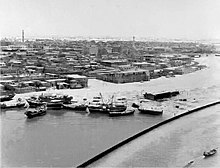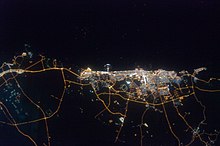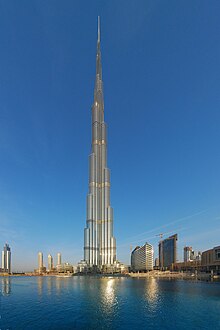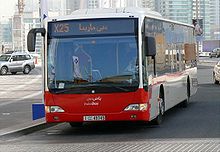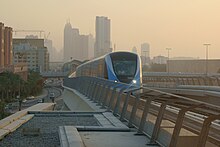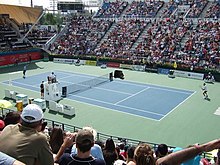| Dubai إمارة دبيّ | |||
|---|---|---|---|
| — Emirate — | |||
| Emirate of Dubai | |||
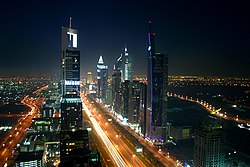 | |||
| |||
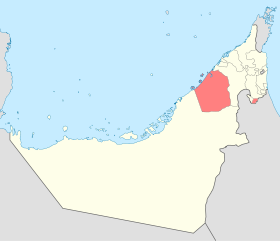 Dubai | |||
| Coordinates: 25°15′00″N 55°18′00″E | |||
| Country | |||
| Emirate | |||
| Incorporated (town) | 9 June 1833 | ||
| Independence from UK | 2 December 1971 | ||
| Founder | Maktoum bin Bati bin Suhail(1833) | ||
| Seat | Dubai | ||
| Subdivisions | |||
| Government | |||
| - Type | Constitutional monarchy[1] | ||
| - Ruler | Mohammed bin Rashid Al Maktoum | ||
| - Crown Prince | Hamdan bin Mohammed bin Rashid Al Maktoum | ||
| Area[2] | |||
| - Emirate | 4,114 km2 (1,588.4 sq mi) | ||
| Population (2010) | |||
| - Emirate | 2,262,000 | ||
| - Density | 408.18/km2 (1,057/sq mi) | ||
| - Metro | 3,410,737 | ||
| - Nationality (2005)[3] | 17% Emirati 9.1% Other Arab nationalities 42.3% Indian 13.3% Pakistani 7.5% Bangladeshi 2.5% Filipino 1.5% Sri Lankan 0.9% European 0.3% American 5.7% other countries | ||
| Time zone | UAE standard time (UTC+4) | ||
| Website | Dubai Emirate Dubai Municipality | ||
Dubai (Arabic: دبيّ Dubeii; IPA: [du'beii]; English pronunciation: /duːˈbaɪ/ doo-by) is a city and emirate in the United Arab Emirates(UAE). The emirate is located south of the Persian Gulf on the Arabian Peninsula and has the largest population with the second-largest land territory by area of all the emirates, after Abu Dhabi.[4] Dubai and Abu Dhabi are the only two emirates to have veto power over critical matters of national importance in the country's legislature.[5] Dubai City is located on the emirate's northern coastline.
The earliest recorded mention of Dubai is in 1095, and the earliest settlement known as Dubai town dates from 1799. Dubai was formally established in 1833 by Sheikh Maktoum bin Buti al Maktoum when he persuaded 800 members of the Bani Yas tribe, living in what is now part of Saudi Arabia, to follow him to the Dubai Creek by the Al Abu Falasa clan of Bani Yas, and it remained under clan control when the United Kingdom assumed the protection of Dubai in 1892.[6] Its geographical location made it an important trading hub and by the beginning of the 20th century, it was an important port. In 1966, the year oil was discovered, Dubai and the emirate of Qatar set up a new monetary unit to replace the Gulf Rupee. The oil economy led to a massive influx of foreign workers, quickly expanding the city by 300% and bringing in international oil interests. The modern emirate of Dubai was created after the UK left the area in 1971. At this time Dubai, together with Abu Dhabi and four other emirates, formed the United Arab Emirates. The following year Ras al Khaimah joined the federation while Qatar and Bahrain chose to remain independent nations. In 1973, the monetary union with Qatar was dissolved and the UAE Dirham introduced throughout the UAE. A free trade zone was built around the Jebel Ali port in 1979, allowing foreign companies unrestricted import of labor and export capital. The Gulf War of 1990 had a negative financial effect on the city, as depositors withdrew their money and traders withdrew their trade, but subsequently the city recovered in a changing political climate and thrived.
Today, Dubai City has emerged as a global city and a business hub.[7] Although Dubai's economy was built on the oil industry, the emirate's model of business drives its economy, with the effect that its main revenues are now from tourism, real estate, and financial services, similar to that of Western countries.[8][9][10] Dubai has recently attracted world attention through many innovative large construction projects and sports events. This increased attention has highlighted labour rights and human rights issues concerning its largely South Asian workforce.[11] Dubai's property market experienced a major deterioration in 2008 and 2009 as a result of the worldwide economic downturn following the Financial crisis of 2007–2010.[12]
Etymology
In the 1820s, Dubai was referred to as Al Wasl by British historians. Few records pertaining to the cultural history of the UAE or its constituent emirates exist and because of the region's oral traditions, folklore and myth were not written down. The linguistic origins of the word Dubai are disputed; some believe it to have originated from the Persian language, while some believe that Arabic is its linguistic root. According to Fedel Handhal, a researcher in the history and culture of the UAE, the word Dubai may have come from the word Daba (a derivative of Yadub, which means to creep); referring to the slow flow of Dubai Creek inland. The poet and scholar Ahmad Mohammad Obaid traces it to the same word, but to itsalternative meaning of locust.[13]
History
Although stone tools have been found at many sites, little is known about UAE's early inhabitants as only a few settlements have been found.[14] Many ancient towns in the area were trading centers between the Eastern and Western worlds. The remnants of an ancient mangrove swamp, dated at 7,000 BC, were discovered during the construction of sewer lines near Dubai Internet City. The area was covered with sand about 5,000 years ago as the coast retreated inland, becoming a part of the city's present coastline.[14][15] Pre Islamic ceramics have been found from the 3rd and 4th century.[16] Prior to Islam, the people in this region worshiped Bajir(or Bajar).[16] The Byzantine and Sassanian (Persian) empires constituted the great powers of the period, with the Sassanians controlling much of the region. After the spread of Islam in the area, the Umayyad Caliph, of the eastern Islamic world, invaded south-east Arabia and drove out the Sassanians. Excavations by the Dubai Museum in the region of Al-Jumayra (Jumeirah) found several artifacts from the Umayyad period.[17]
The earliest recorded mention of Dubai is in 1095, in the "Book of Geography" by theAndalusian-Arab geographer Abu Abdullah al-Bakri. The Venetian pearl merchant Gaspero Balbi visited the area in 1580 and mentioned Dubai (Dibei) for its pearling industry.[17]Since 1799, there has been a settlement known as Dubai town.[18] In the early 19th century, the Al Abu Falasa clan (House of Al-Falasi) of Bani Yas clan established Dubai, which remained a dependent of Abu Dhabi until 1833.[19] On 8 January 1820, the sheikhof Dubai and other sheikhs in the region signed the "General Maritime Peace Treaty" with the British government.[14] In 1833, following tribal feuding, the Al Maktoum dynasty (also descendants of the House of Al-Falasi) of the Bani Yas tribe left their ancestral home of the Liwa Oasis, South-west of the settlement of Abu Dhabi and quickly took over Dubai from the Abu Fasala clan without resistance.[19]
Dubai came under the protection of the United Kingdom by the "Exclusive Agreement" of 1892, in which the UK agreed to protect Dubai against the Ottoman Empire.[19] Two catastrophes struck the town during the 1800s. First, in 1841, a smallpox epidemic broke out in the Bur Dubai locality, forcing residents to relocate east to Deira. Then, in 1894, fire swept through Deira, burning down most homes.[20] However, the town's geographical location continued to attract traders and merchants from around the region. The emir of Dubai was keen to attract foreigntraders and lowered trade tax brackets, which lured traders away from Sharjah and Bandar Lengeh, which were the region's main trade hubs at the time. Persian merchants naturally looked across to the Arab shore of the Gulf finally making their homes in Dubai. They continued to trade with Lingah, however, as do many of the dhows in Dubai Creek today, and they named their district Bastakiya, after the Bastak region in southern Persia.[20][21]
Dubai's geographical proximity to Iran made it an important trade location. The town of Dubai was an important port of call for foreign tradesmen, chiefly those from Iran, many of whom eventually settled in the town. By the beginning of the 20th century, it was an important port.[18] Dubai was known for its pearl exports until the 1930s; the pearl trade was damaged irreparably by World War I, and later on by theGreat Depression in the 1930s. With the collapse of the pearling industry, Dubai fell into a deep depression and many residents starved or migrated to other parts of the Persian Gulf.[14]
Geography
Climate
[edit]Governance and politics
[edit]Human rights
Article 25 of the Constitution of the UAE provides for the equitable treatment of persons with regard to race, nationality, religious beliefs or social status. However, many of Dubai's 250,000 foreign labourers live in conditions described by Human Rights Watch as being "less than human."[44][45][46] NPR reports that workers "typically live eight to a room, sending home a portion of their salary to their families, whom they don't see for years at a time." On 21 March 2006, workers at the construction site of Burj Khalifa, upset over bus timings and working conditions, rioted: damaging cars, offices, computers, and construction tools.[47][48][49][50] The global financial crisis has caused the working class of Dubai to be affected especially badly, with many workers not being paid but also being unable to leave the country.[51]
Alleged labour injustices in Dubai have attracted the attention of various human rights groups, which have tried to persuade the government to become a signatory to two of theInternational Labour Organization's eight core conventions, which allows for the formation of labour unions. The Dubai government, however, denied any kind of labour injustices and stated that the watchdog's accusations were misguided.[52] Towards the end of March 2006, the government announced steps to allow construction unions. UAE labour minister Ali al-Kaabi said: "Labourers will be allowed to form unions".[53]
Prostitution, though illegal, is conspicuously present in the emirate because of its very large male/female imbalance. Research conducted by the American Center for International Policy Studies (AMCIPS) found that Russian and Ethiopian women are the most common prostitutes, as well as women from some African countries, while Indian prostitutes are part of a well organised trans-Oceanic prostitution network.[54] A 2007 PBS documentary entitled Dubai: Night Secrets reported that prostitution in clubs is tolerated by authorities and many foreign women work there without being coerced.[54][55]
[edit]Demographics
See also: Islam in the United Arab Emirates, Bahá'í Faith in the United Arab Emirates, Indians in the United Arab Emirates, and Pakistanis in the United Arab Emirates
According to the census conducted by the Statistics Centre of Dubai, the population of the emirate was 1,771,000 as of 2009, which included 1,370,000 males and 401,000 females.[63] The region covers 497.1 square miles (1,287.4 km²). The population density is 408.18/km² – more than eight times that of the entire country. Dubai is the second most expensive city in the region, and 20th most expensive city in the world.[64]
As of 2005, 17% of the population of the emirate was made up of UAE nationals. Approximately 85% of the expatriate population (and 71% of the emirate's total population) was Asian, chiefly Indian (51%), Pakistani (16%), Bangladeshi (9%) and Filipino (3%) and a sizeable community of Somalisnumbering around 30,000.[3][65] A quarter of the population however reportedly traces their origins to Iran.[66] In addition, 16% of the population (or 288,000 persons) living in collective labour accommodation were not identified by ethnicity or nationality, but were thought to be primarily Asian.[67] The median age in the emirate was about 27 years. The crude birth rate, as of 2005, was 13.6%, while the crude death rate was about 1%.[68] Although Arabic is the official language, English is the lingua franca of the city and is very widely spoken by the majority of its residents either as a primary or secondary language. Other languages spoken by Dubai's many foreign residents include Hindi, Urdu, Bengali, Tamil, Tagalog, Farsi, Chinese, andMalayalam.[69]
Article 7 of the UAE's Provisional Constitution declares Islam the official state religion of the UAE. The government subsidises almost 95% of mosques and employs all Imams; approximately 5% of mosques are entirely private, and several large mosques have large private endowments.[70]
Dubai also has large Hindu, Christian, Bahá'í, Sikh, Buddhist, and other religious communities residing in the city.[71] Non-Muslim groups can own their own houses of worship, where they can practice their religion freely, by requesting a land grant and permission to build a compound. Groups that do not have their own buildings must use the facilities of other religious organisations or worship in private homes.[72] Non-Muslim religious groups are permitted to openly advertise group functions; however, proselytising or distributing religious literature is strictly prohibited under penalty of criminal prosecution, imprisonment, and deportation for engaging in behaviour offensive to Islam.[70]
[edit]Economy
Main article: Economy of Dubai
Dubai's gross domestic product as of 2008 was US$ 82.11 billion.[73] Although Dubai's economy was built on the back of the oil industry,[74]revenues from oil and natural gas currently account for less than 6% of the emirate's revenues.[8] It is estimated that Dubai produces 50,000 to 70,000 barrels (11,000 m3) of oil a day[75] and substantial quantities of gas from offshore fields. The emirate's share in UAE's gas revenues is about 2%. Dubai's oil reserves have diminished significantly and are expected to be exhausted in 20 years.[76] Real estate and construction (22.6%),[10] trade (16%), entrepôt (15%) and financial services (11%) are the largest contributors to Dubai's economy.[77] Dubai's top exportingdestinations include India (US$ 5.8 billion), Switzerland (US$ 2.37 billion) and Saudi Arabia (US$ 0.57 billion). Dubai's top re-exporting destinations include India (US$ 6.53 billion), Iran (US$ 5.8 billion) and Iraq (US$ 2.8 billion). The emirate's top import sources are India (US$ 12.55 billion), China (US$ 11.52 billion) and the United States (US$ 7.57 billion). As of 2009 India was Dubai's largest trade partner.[78]
Historically, Dubai and its twin across the Dubai creek, Deira (independent of Dubai City at that time), were important ports of call for Western manufacturers. Most of the new city's banking and financial centres were headquartered in the port area. Dubai maintained its importance as a trade route through the 1970s and 1980s. Dubai has a free trade in gold and, until the 1990s, was the hub of a "brisk smuggling trade"[18] of gold ingots to India, where gold import was restricted. Dubai's Jebel Ali port, constructed in the 1970s, has the largest man-made harbour in the world and was ranked seventh globally for the volume of container traffic it supports.[79] Dubai is also a hub for service industries such as information technology and finance, with industry-specific free zones throughout the city. Dubai Internet City, combined with Dubai Media Cityas part of TECOM (Dubai Technology, Electronic Commerce and Media Free Zone Authority) is one such enclave whose members include IT firms such as EMC Corporation, Oracle Corporation, Microsoft, and IBM, and media organisations such as MBC, CNN, BBC, Reuters, Sky News and AP.
The government's decision to diversify from a trade-based, oil-reliant economy to one that is service and tourism-oriented made property more valuable, resulting in the property appreciation from 2004–2006. A longer-term assessment of Dubai's property market, however, showed depreciation; some properties lost as much as 64% of their value from 2001 to November 2008.[80] The large scale real estate development projects have led to the construction of some of the tallest skyscrapers and largest projects in the world such as the Emirates Towers, the Burj Khalifa, the Palm Islands and the world's second tallest, and most expensive hotel, the Burj Al Arab.[81] The Dubai Financial Market (DFM) was established in March 2000 as a secondary market for trading securities and bonds, both local and foreign. As of fourth quarter 2006, its trading volume stood at about 400 billion shares, worth $95 billion in total. The DFM had a market capitalisation of about $87 billion.[67]
Dubai's property market experienced a major downturn in 2008 and 2009 as a result of the slowing economic climate.[12] Mohammed al-Abbar, Chief Executive Officer of Emaar told the international press in December 2008 that Emaar had credits of $70 billion and the state of Dubai additional $10 billion while holding estimated $350 billion in real estate assets. By early 2009, the situation had worsened with the global economic crisis taking a heavy toll on property values, construction and employment.[82] As of February 2009 Dubai's foreign debt was estimated at approximately $80 billion, although this is a tiny fraction of the sovereign debt worldwide.[83]
A City Mayors survey rated Dubai as 44th among the world's best financial cities in 2007,[84] while another report by City Mayors indicated that Dubai was the world's 33rd richest city in 2009, in terms of purchasing power parity (PPP).[85] Dubai is also an international financial centre and has been ranked 37th within the top 50 global financial cities as surveyed by the Mastercard Worldwide Centres of Commerce Index (2007),[86] and 1st within the Middle East.
[edit]Tourism and retail
See also: Tourism in Dubai
Tourism is an important part of the Dubai government's strategy to maintain the flow of foreign cash into the emirate. Dubai's lure for tourists is based mainly on shopping, but also on its possession of other ancient and modern attractions. As of 2007, Dubai was the 8th most visited city of the world.[87] Dubai is expected to accommodate over 15 million tourists by 2015.[88] Dubai is the most populous emirate of the seven emirates of United Arab Emirates. It is distinct from other members of the UAE in that a large part of the emirate's revenues are from tourism.[89]
Dubai has been called the "shopping capital of the Middle East".[90] Dubai alone has more than 70 shopping malls, including the world's 7th largest shopping mall, Dubai Mall. The city draws large numbers of shopping tourists from countries within the region and from as far as Eastern Europe, Africa and the Indian Subcontinent. While boutiques, some electronics shops, department stores and supermarkets operate on a fixed-price basis, most other outlets consider friendly negotiation a way of life.[91]
Dubai is also known for its souk districts located on either side of the creek. Traditionally, dhows from the Far East, China, Sri Lanka, and India would discharge their cargo and the goods would be bargained over in the souks adjacent to the docks.[92] Many boutiques and jewellery stores are also found in the city. Dubai is known as "the City of Gold" and Gold Souk in Deira houses nearly 250 gold retail shops.[93] Dubai Duty Free Company at the Dubai International Airport offers merchandise catering to the multinational passengers using the airport.
Cityscape
Architecture
See also: List of tallest buildings in Dubai
Dubai has a rich collection of buildings and structures of various architectural styles. Many modern interpretations of Islamic architecture can be found here, due to a boom in construction and architectural innovation in the Arab World in general, and in Dubai in particular, supported not only by top Arab or international architectural and engineering design firms such as Al Hashemi and Aedas, but also by top firms of New York and Chicago.[94] As a result of this boom, modern Islamic – and world – architecture has literally been taken to new levels in skyscraper building design and technology. Dubai now boasts more completed or topped-out skyscrapers higher than 2/3 km, 1/3 km, or 1/4 km than any other city. A culmination point was reached in 2010 with the completion of the Burj Khalifa (Khalifa Tower), now by far the world's tallest building at 828 m (2,717 ft). The Burj Khalifa's design is derived from the patterning systems embodied in Islamic architecture, with the triple-lobed footprint of the building based on an abstracted version of the desert flower hymenocallis which is native to the Dubai region.[95] The completion of the Khalifa Tower, following the construction boom that began in the 1980s, accelerated in the 1990s, and took on a rapid pace of construction unparalled in modern human history during the decade of the 2000s, leaving Dubai with the world's tallest skyline as of 4 January 2010.[96][97]
Burj al Arab
The Burj Al Arab (Arabic: برج العرب, "Tower of the Arabs") is a luxury hotel in Dubai, United Arab Emirates managed by the Jumeirah Group and built by Said Khalil. Its construction started in 1994 and ended in 1999. It was designed by Tom Wright of WS Atkins PLC. The hotel cost $650,000,000 to build. At 321 metres (1,053 ft) and 60 floors, it was the tallest building used exclusively as a hotel until being succeeded byRose Rayhaan by Rotana in 23 December 2009, again in Dubai. The Burj Al Arab stands on an artificial island 280 metres (919 ft) out from Jumeirah beach, and is connected to the mainland by a private curving bridge. It is an iconic structure, designed to symbolize Dubai's urban transformation and to mimic the sail of a boat.



